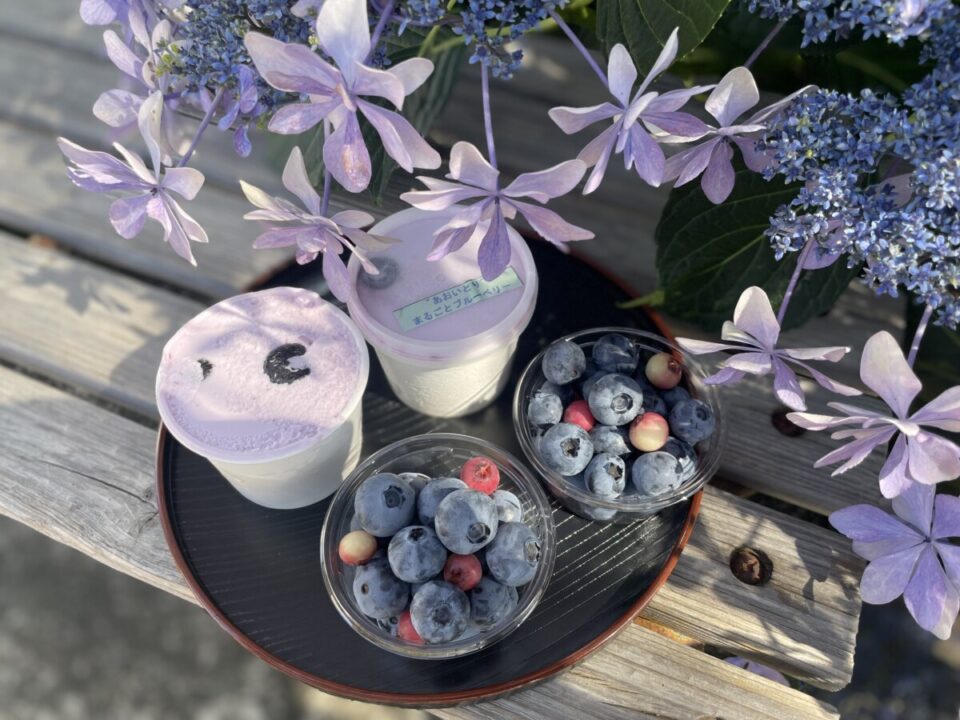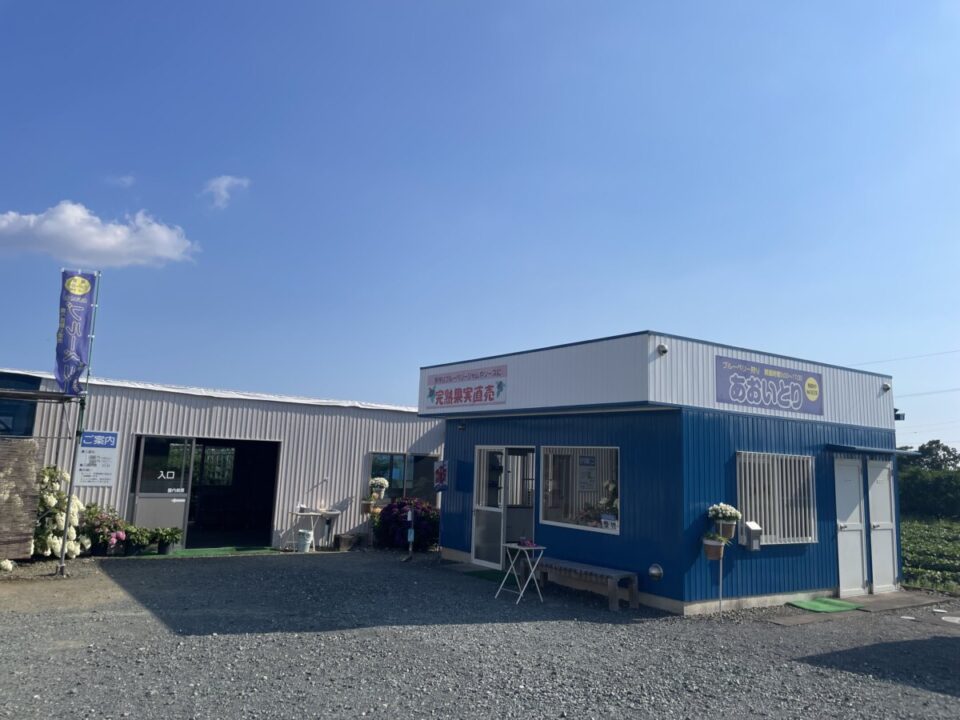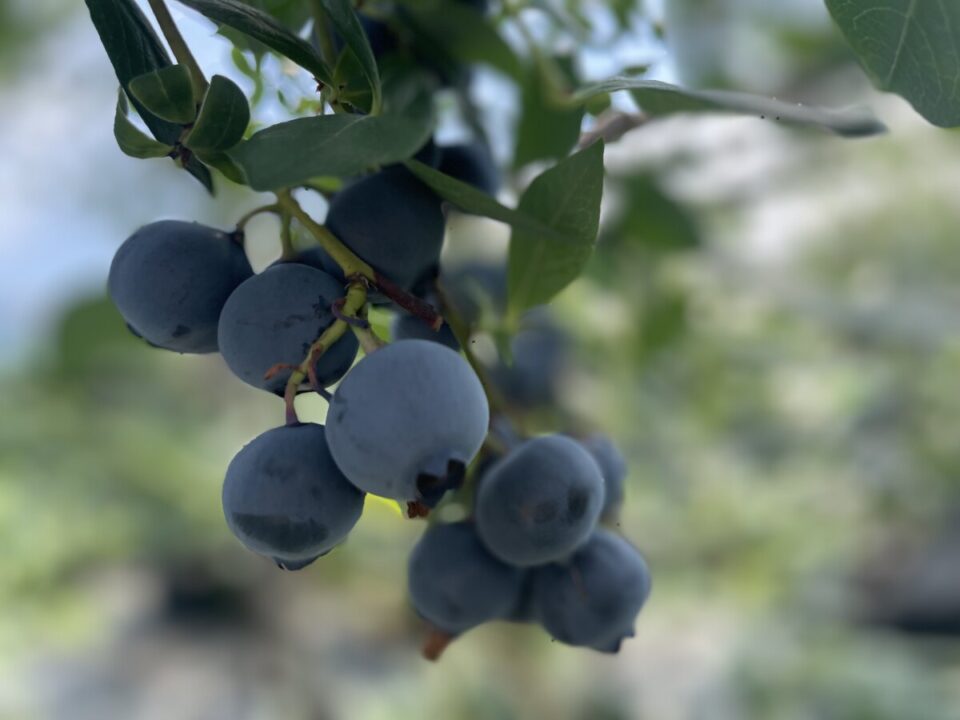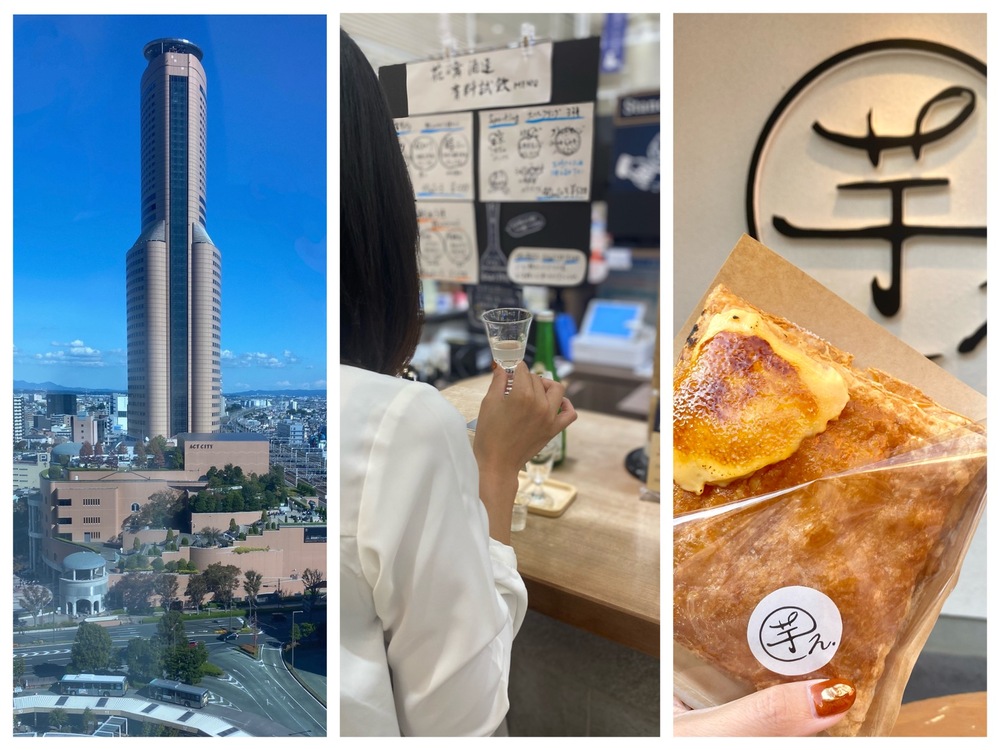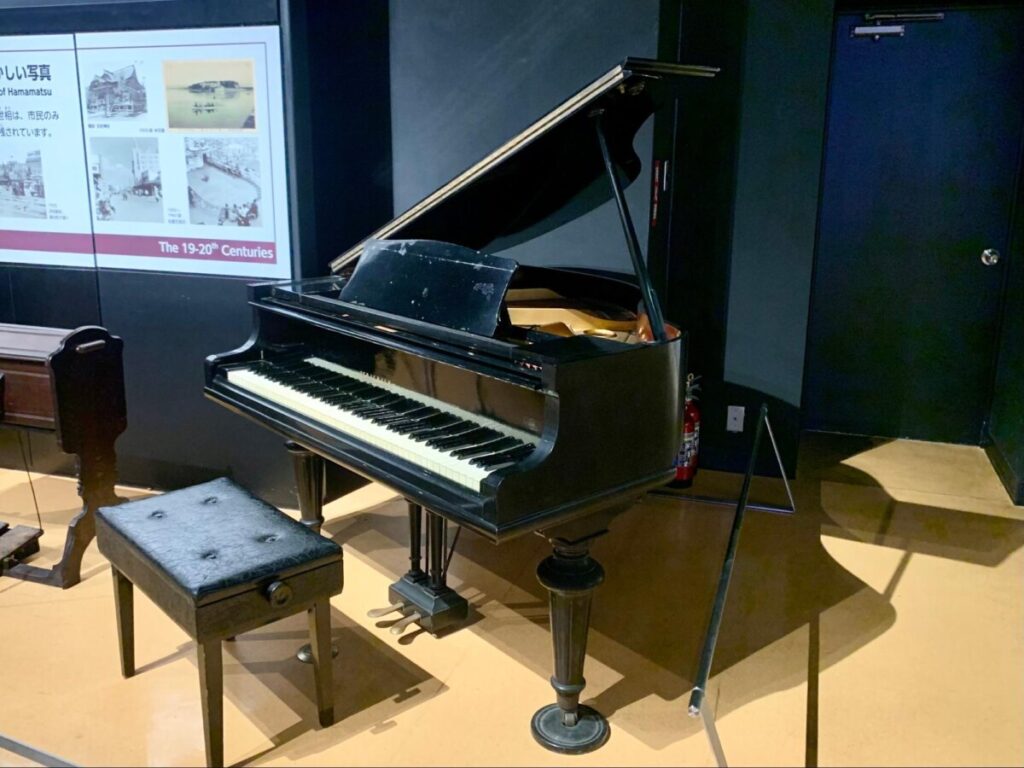Get to Know Hamamatsu
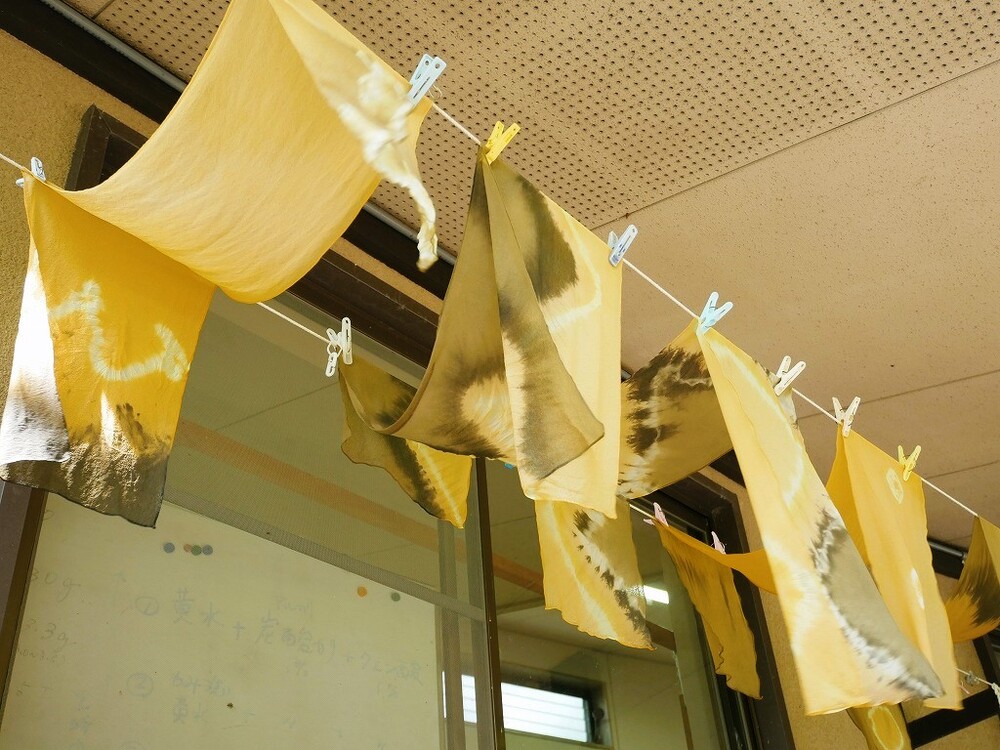
- Enjoy
Try your hand at dyeing with plants at Manyo-no-Mori Park! Let’s make one just for you
At Manyo-no-Mori Park in Hamakita Ward, a Manyo plant dyeing experience is held four times a year (approximately once every three months).
At the Kibe Kibe workshop located within the park, you can enjoy itajime and tie-dyeing using plants that appear in the Manyoshu, such as safflower, indigo, and madder.
This time we will introduce silk chiffon dyeing using the leaves of Asebi Asebi. We took on the challenge of making an original stole using three types of mordant while learning from Mr. Miki from the machine workshop!
The experience time is approximately 2 hours. Even those who are new to vegetable dyeing can easily participate.
Try your hand at plant dyeing at Manyo-no-Mori Park!
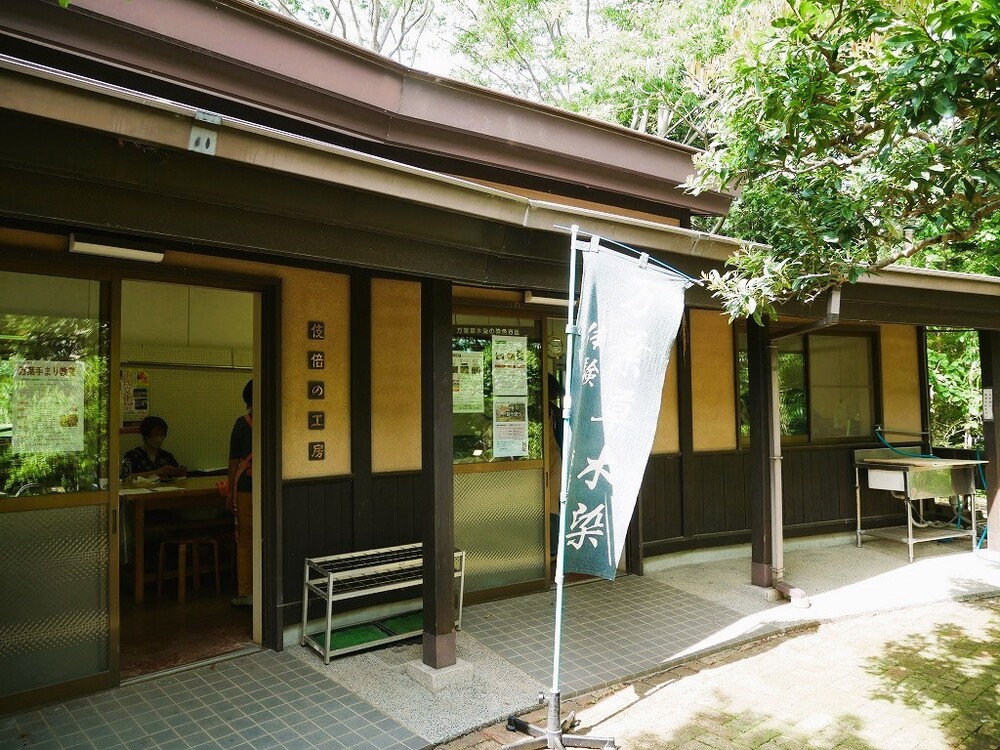
▲Kibe’s workshop
Approximately 11 kilometers north of JR Hamamatsu Station.
At the “Kibabe Kibe no Kobo” located in Manyo-no-Mori Park, you can experience Manyo plant dyeing using flowers and pruned branches and leaves found in the park four times a year (approximately once every three months).
The person who will be teaching us is Mr. Miki of the machine workshop, who has been holding dyeing experience sessions at the same workshop since 2019.
Beginners can feel at ease as they will provide detailed instructions on dyeing methods, how to create patterns on cloth, and the plants that can be used as dyeing materials.
There are various dyeing materials such as safflower, indigo, cherry blossom, and chestnut. Each participant makes their own pattern on the cloth, so they can create an original piece of cloth.
However, there are some people who think, “I’m interested in vegetable dyeing, but I don’t know what to prepare and it seems difficult to prepare.”
On the day of the event, all you need to do is pay the participation fee (2,500 yen, including dye and cloth), as well as bring an apron, gloves, and towel. If you want to take notes, there are also writing utensils available.
Gloves are used when squeezing the cloth soaked in the dye solution, so rubber or vinyl gloves are recommended. The dye solution, mordant solution (liquid that fixes the dyed color onto the fabric), and fabric are all prepared.
The vegetable dyeing techniques that you can experience are two of the three major dyeing methods of the Nara period, sankechi: Itajime dyeing (Kokechi) and Shibori-jime (Kokechi).
In the case of KokechI, the fabric to be dyed is tightly sandwiched between the boards, and in the case of kokechi, the fabric is wrung or sewn to prevent the parts of the fabric that want to retain their color from being dyed.
The remaining Sankechi is wax dyeing.
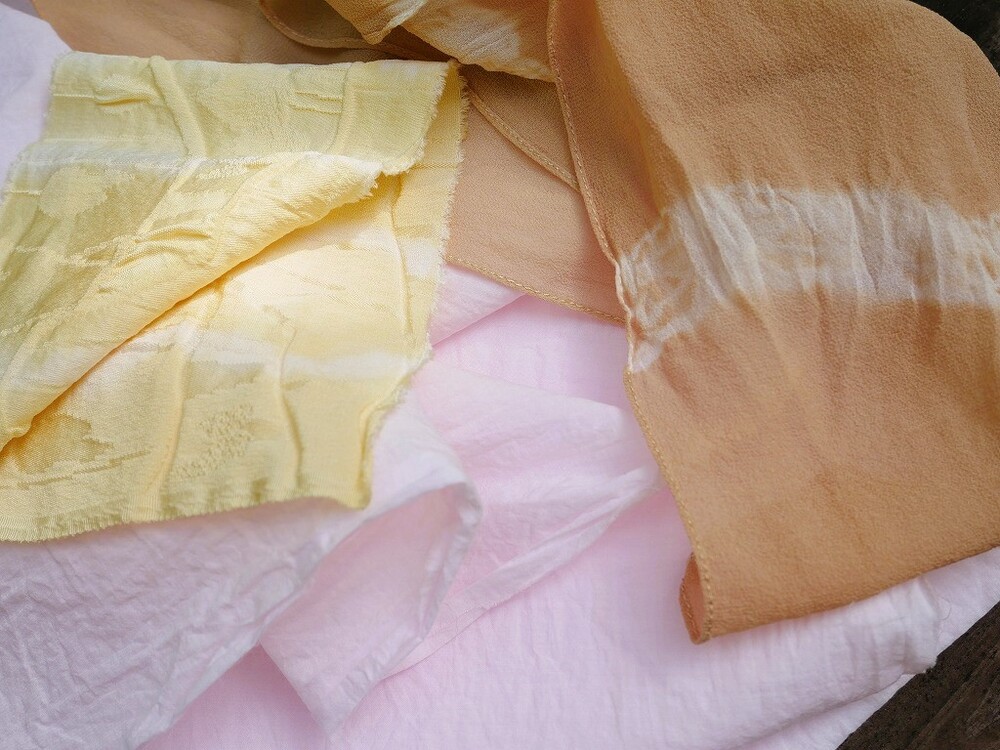
▲Left: Safflower (stained with yellow water), Center: Safflower (normal dyed), Right: Cherry bark (both dyed by the author)
The image above is what I dyed with safflower and cherry blossoms when I tried Manyo plant dyeing in 2022.
When dyeing with safflower, you may have the impression that it will be dyed pink or crimson. However, if you dye it with the first colored water (yellow water), which is usually thrown away, it will turn yellow like this.
In 2021, two members of Sea Lake HAMANA Jenne (Jenne Takahashi and Jenne Yusa) also had a safflower dyeing experience.
Also featured on YouTube channel “Jenne Channel”▼
[Shizuoka Prefecture/Hamamatsu Tourism] Plant dyeing in Hamakita, experience traditional dyeing techniques at Manyo no Mori Park!
What color will you get if you dye it with Asebi?
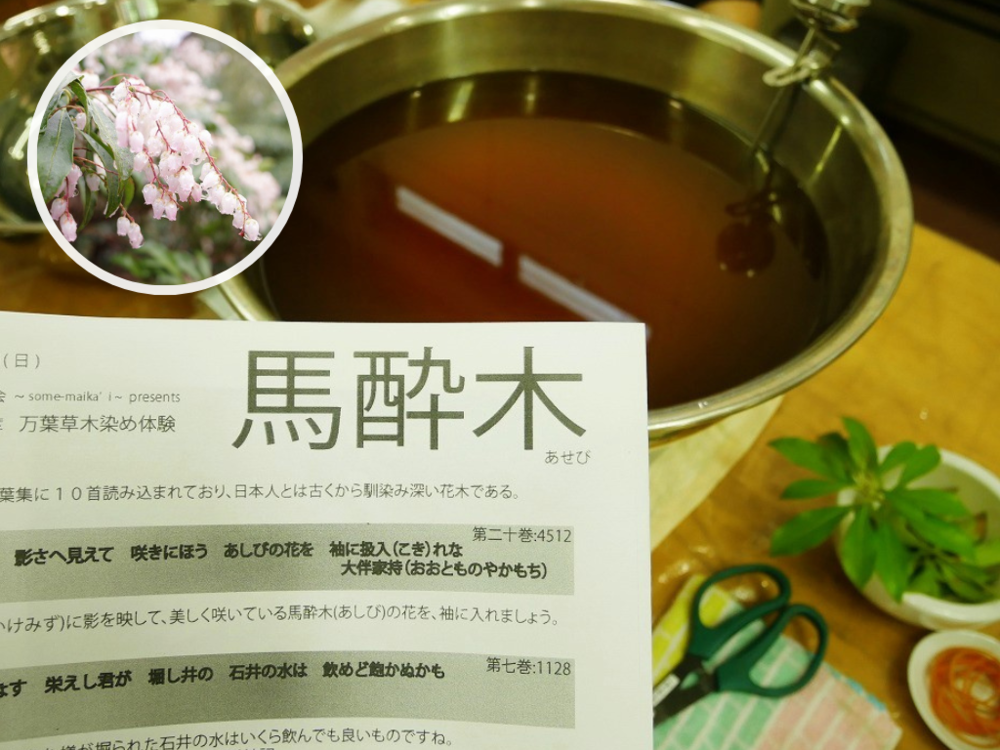
▲Inside the circle on the upper left: Flowers of the horse-sucking tree
This time’s dyeing material, Asebi Asebi, is an evergreen shrub that blooms small pot-shaped flowers from March to May, and contains toxic ingredients. In Basuiki dyeing, the leaves are boiled and extracted, and the extracted pigment is used as a dye solution.
Although the leaves are green, the dye is reddish brown as you can see. However, this dye solution was extracted three days ago, and the freshly extracted dye solution will be a candy color.
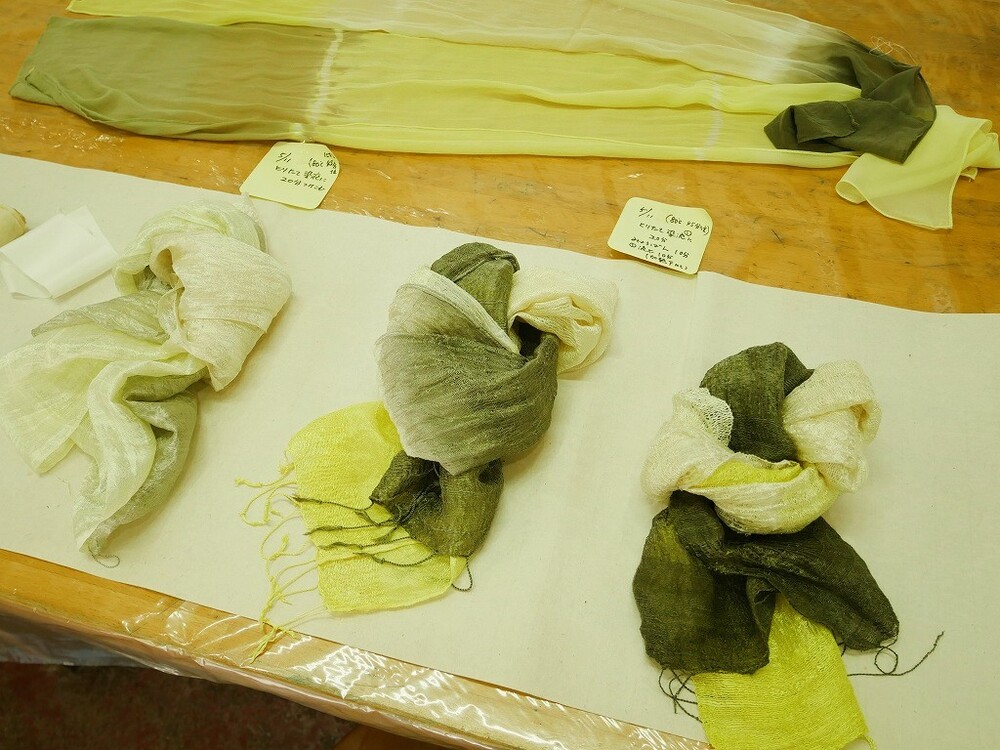
Differences in color are easy to see, such as those that have just been soaked in dye liquor and those that have been mixed with dye liquor and mordant.
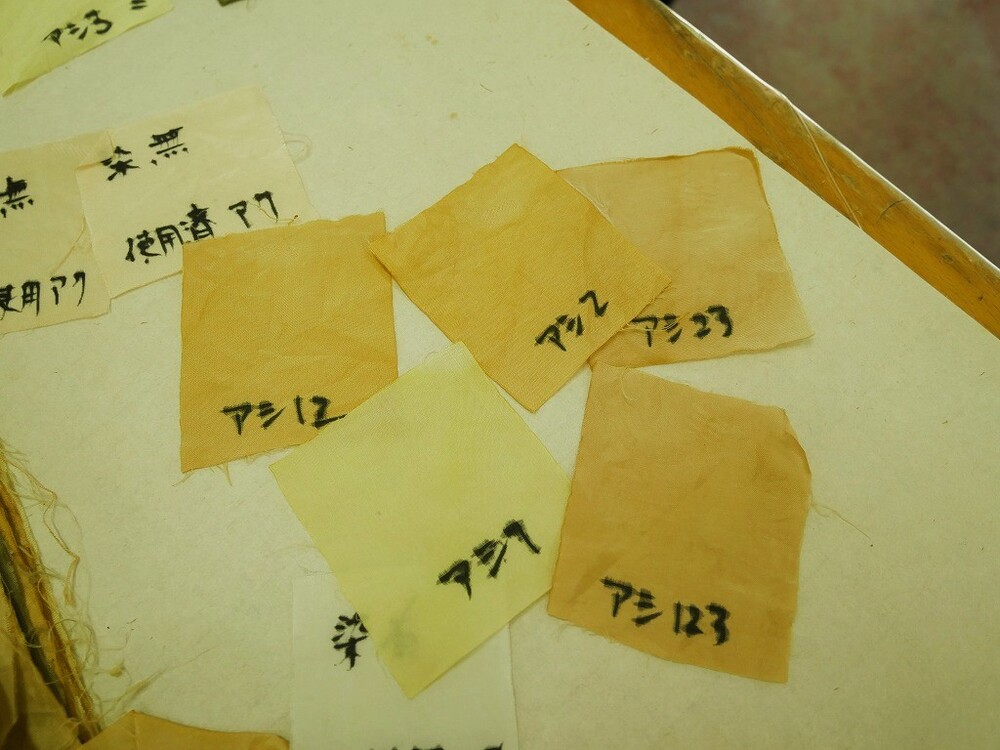
▲Dyeing samples with different mordanting times
On the table in the workshop, there are samples of stoles dyed with horse-stained wood.
You can see the difference in color between the dye that has just been immersed in the freshly extracted dye solution and the mordant.
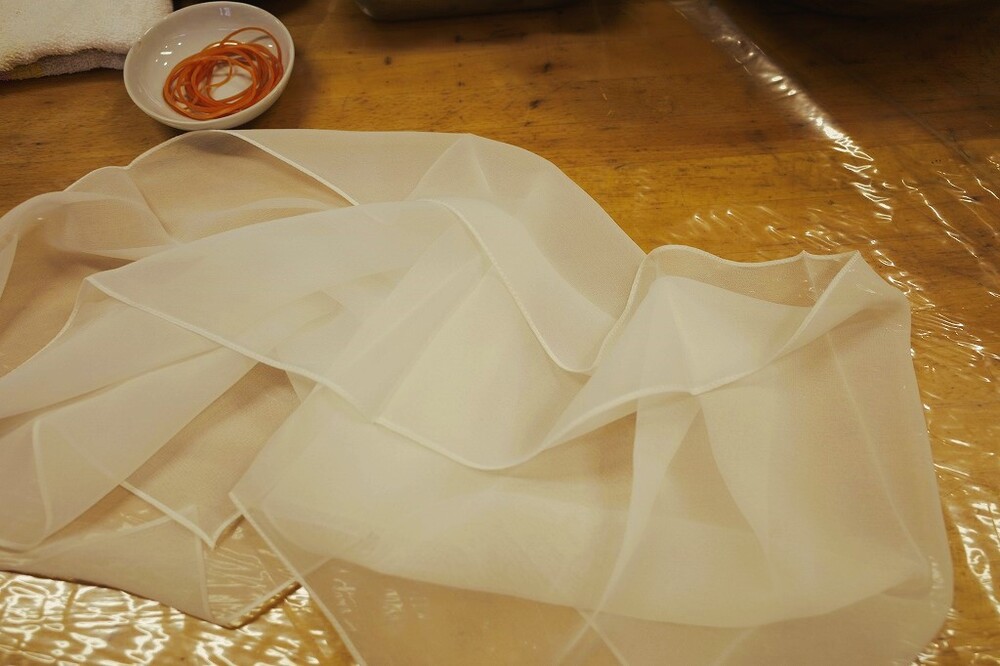
▲Dyed fabric (silk chiffon scarf)
The fabric to be dyed is silk chiffon, which is soft and light and transparent. The length is over 1 meter.
Because the fabric is thin, this time we will not tie it up (jote), but use tie-dyeing (kotetsu) to create the pattern.
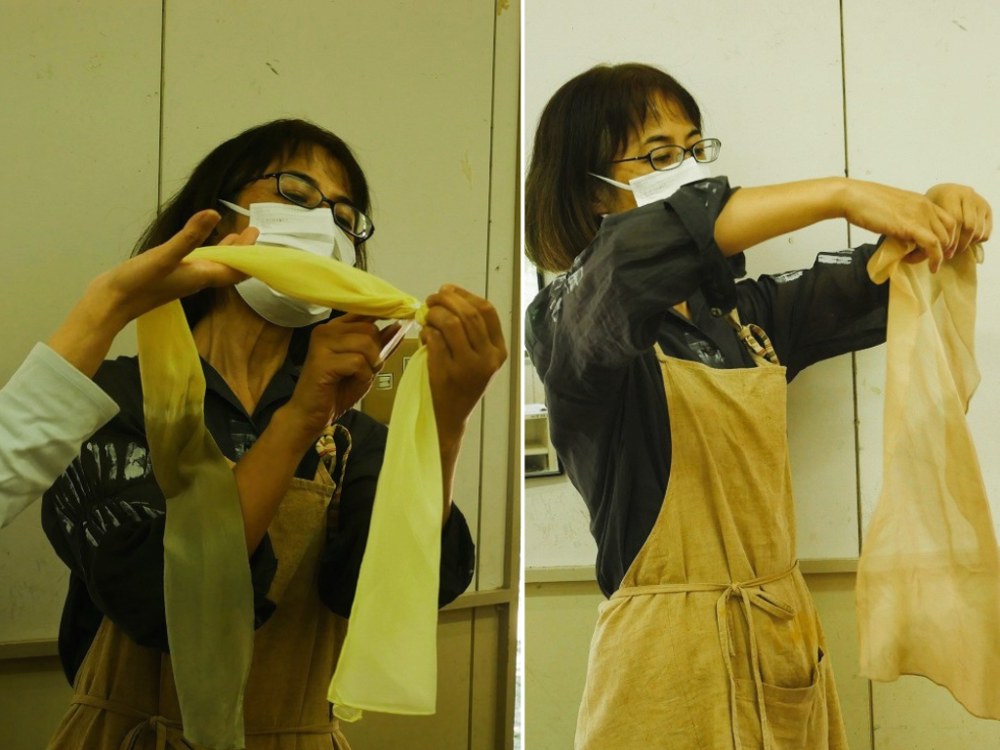
▲Lecture on how to squeeze by Mr. Miki (Left: How to squeeze using a string, Right: How to draw the dough by hand)
Before actually soaking the cloth in the dye solution, Miki-sensei will teach you how to dye it and how to squeeze the cloth.
The dyeing experience has finally begun!
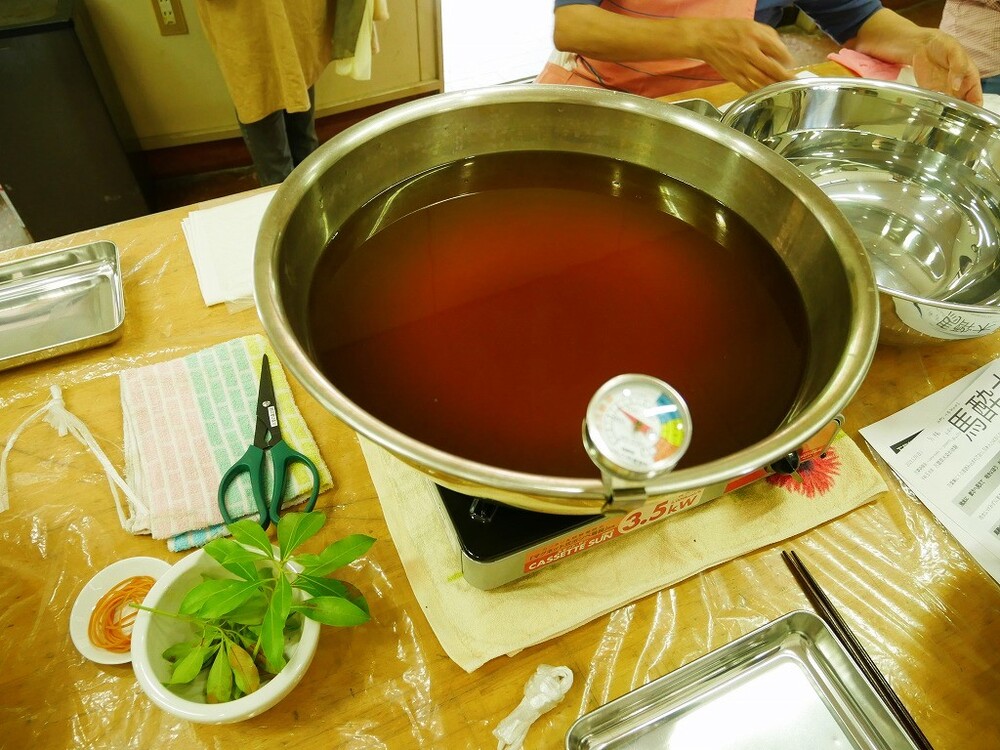
▲Center: Already boiled dye solution (Bottom left: Leaves of horse-sucking tree)
Now, let’s dye it!
The dye solution is already at the appropriate temperature (80℃), so all you have to do is soak the fabric and dye it.
The dye solution will not get into the areas squeezed with a rubber band or string and will remain white, so take this into account when squeezing with a rubber band or string.
Pick up a piece of cloth and squeeze it with a rubber band, or crumple it up and squeeze it with a rubber band or string. How you create the pattern is up to you. Try different things!
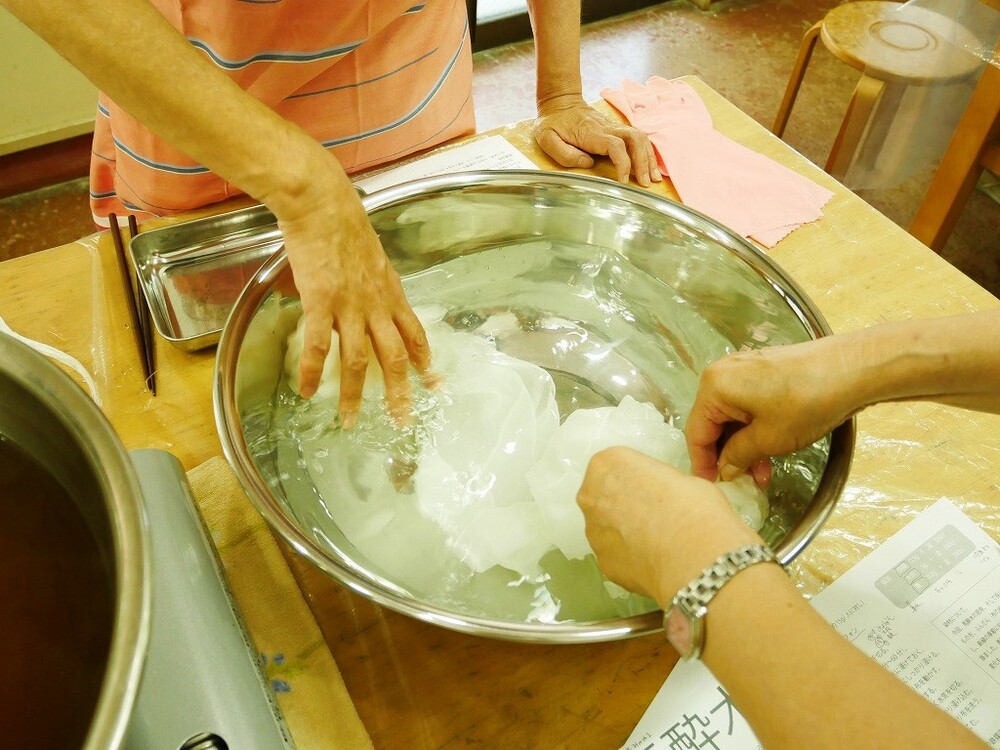
Next, soak the wrung cloth in fresh water to prevent uneven coloring.
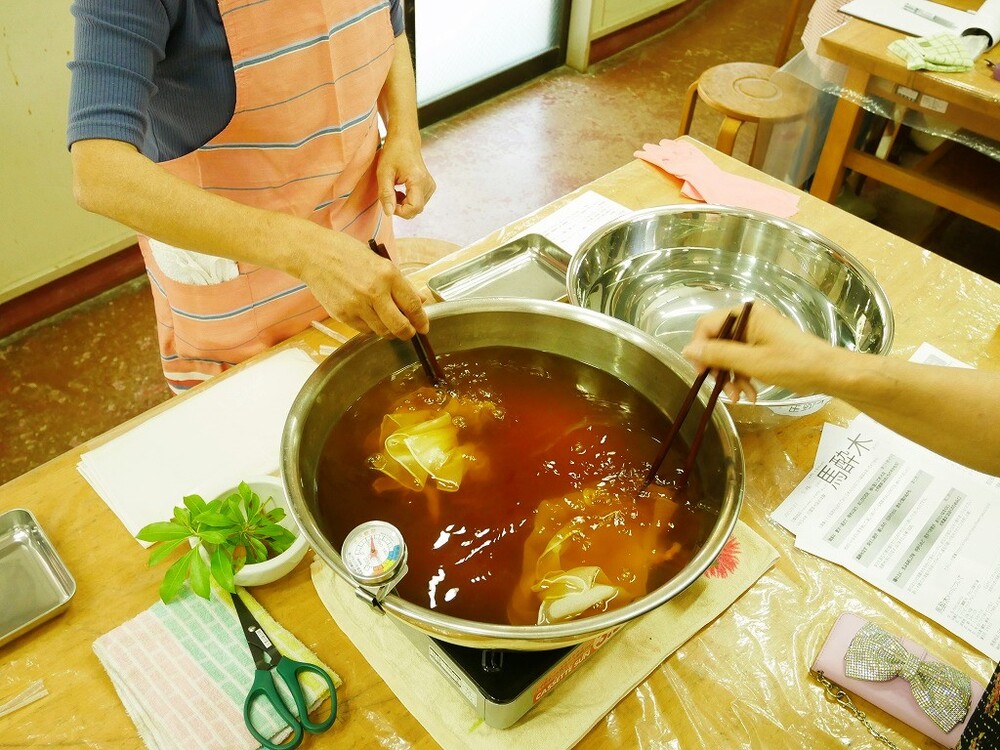
Squeeze the cloth soaked in water and soak it thoroughly in the dye solution.
Soaking time is 20 minutes. During this time, move the chopsticks evenly so that the entire cloth is dyed.
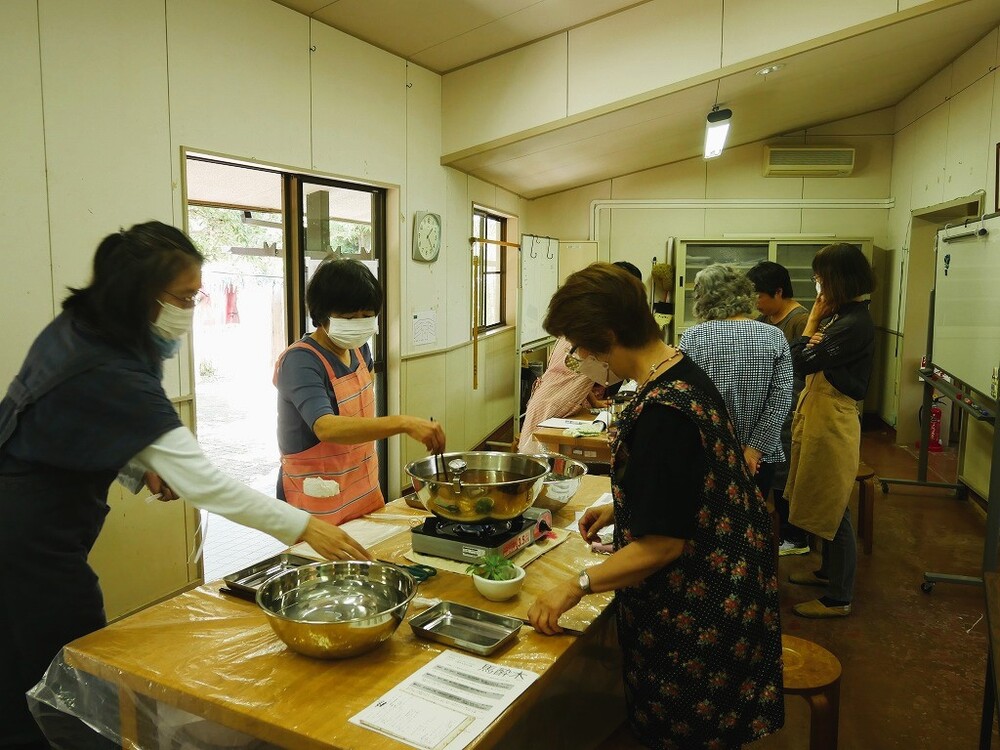
▲Any questions you may have will be resolved with the advice of Miki Sensei.
Miki-sensei will give you appropriate advice regarding your wishes and questions, such as “I want the dyed finish to look like this.”
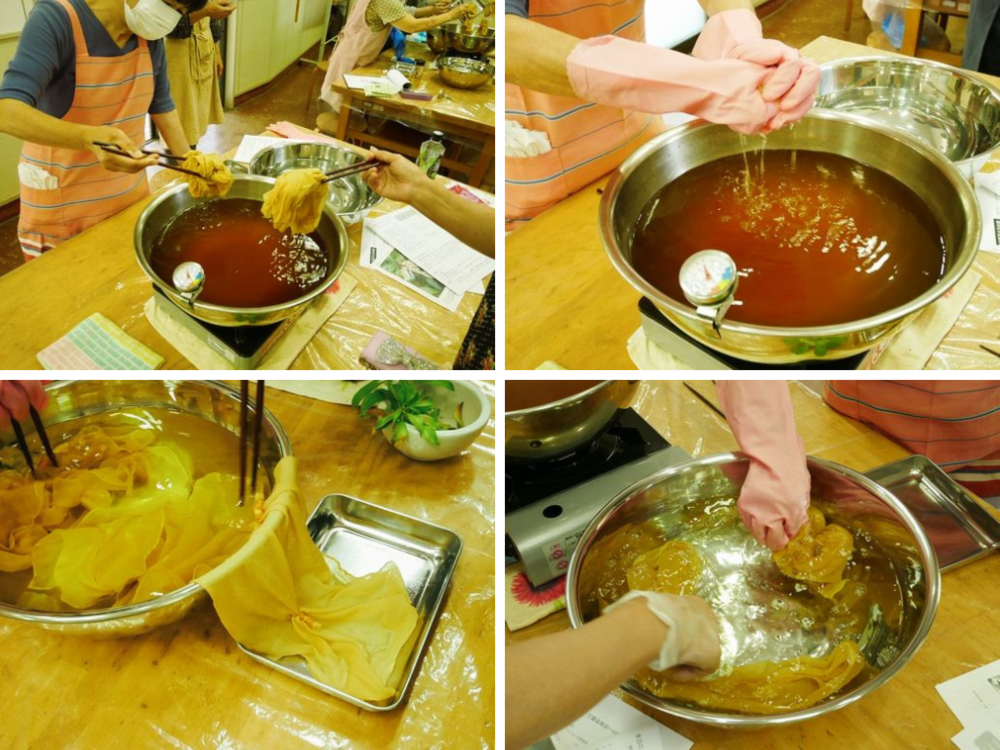
▲Top left: Remove the cloth from the dye solution.Top right: Hold the cloth with both hands and drain well.Bottom left: Soak the cloth in alum (mordant).Bottom right: Wash the cloth thoroughly in a bowl of fresh water.
After 20 minutes, remove the cloth from the dye solution and press it with both hands to drain well. The cloth you take out will be a little hot, so be careful.
Then, soak it in a mordant solution for 10 minutes to allow the dyed color to set.
The main mordants used in vegetable dyeing are aluminum mordant, alkaline mordant, and iron mordant. The mordant used this time is soaked in all three types in order. I’m looking forward to seeing how it turns out in the end.
The first mordant is alum (aluminum mordant). After 10 minutes, remove the cloth from the mordant and wash it thoroughly in a bowl of fresh water.
After washing, squeeze the cloth and add it to the dye solution again. The second soaking time is the same as the first time, 20 minutes.
There is an explanation of dye plants while waiting.
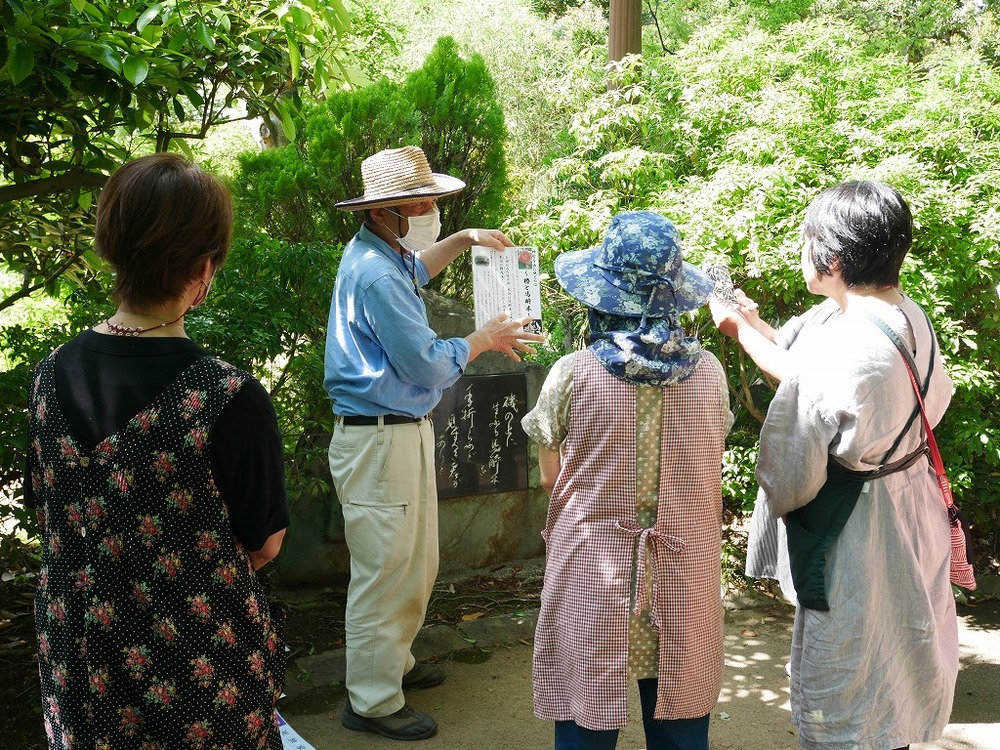
▲All the participants listening intently to the experience (the plant on the right is a pine tree)
During the Manyo plant dyeing experience, the Manyo no Mori Park staff will provide a guide about dyeing plants during the second soak in the dye solution.
This time’s dyed material, Basuigi, can be seen all over the park, and there are manyo poem monuments nearby.
“You are the one who deserves to see the living horsewood tree on the rocky shore, even if it is folded in your hands.”
There are also things that stand up.
The poem engraved on the monument was written by Princess Okuno Himemiko (Princess Daihoku) during the Asuka period in memory of her younger brother Otsu Prince Otsunomiko, who was embroiled in a dispute over the imperial succession and was executed on suspicion of rebellion. It’s a song.
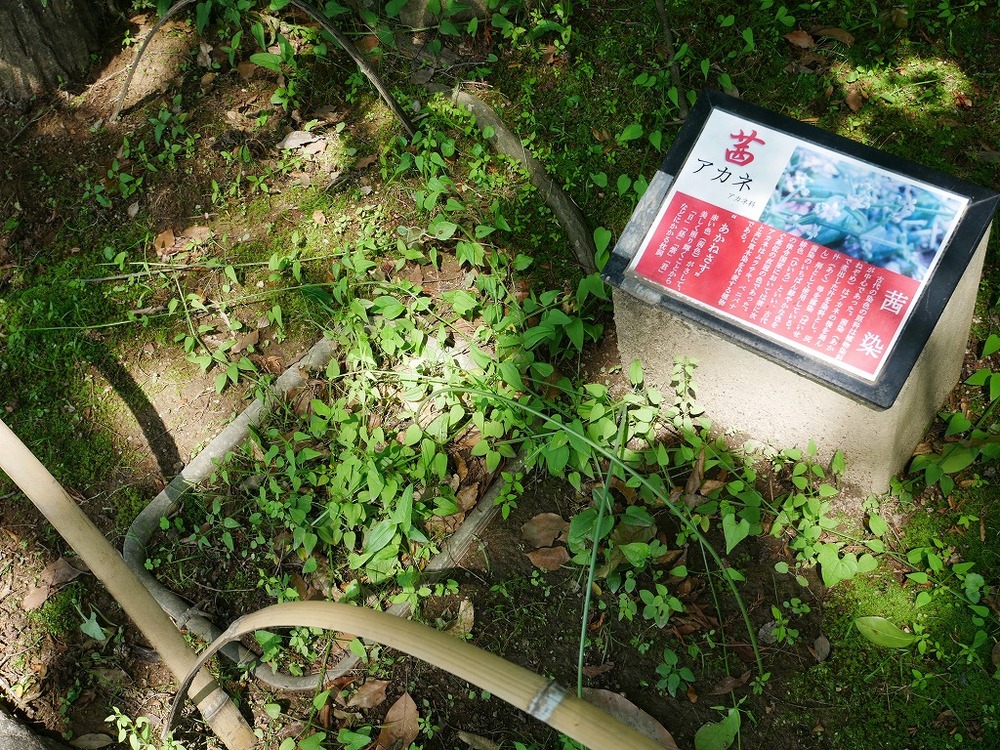
▲Akane (root used for vegetable dyeing)
In the park, you can see other plants that can be used as dyeing materials, such as madder, purple, and safflower.
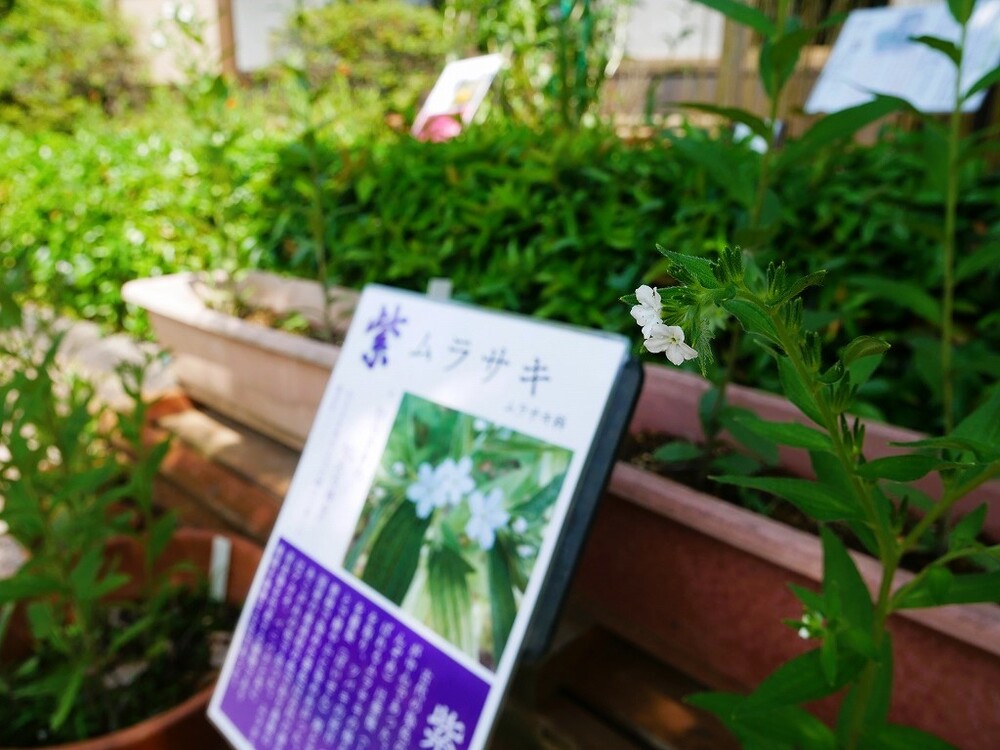
▲Purple (roots are used for plant dyeing)
When I dyed Basui wood, it was right around the time when the purple flowers were blooming. Madder and purple extract the dye from the roots, not the leaves.
Don’t you think it’s strange that roots contain pigment?
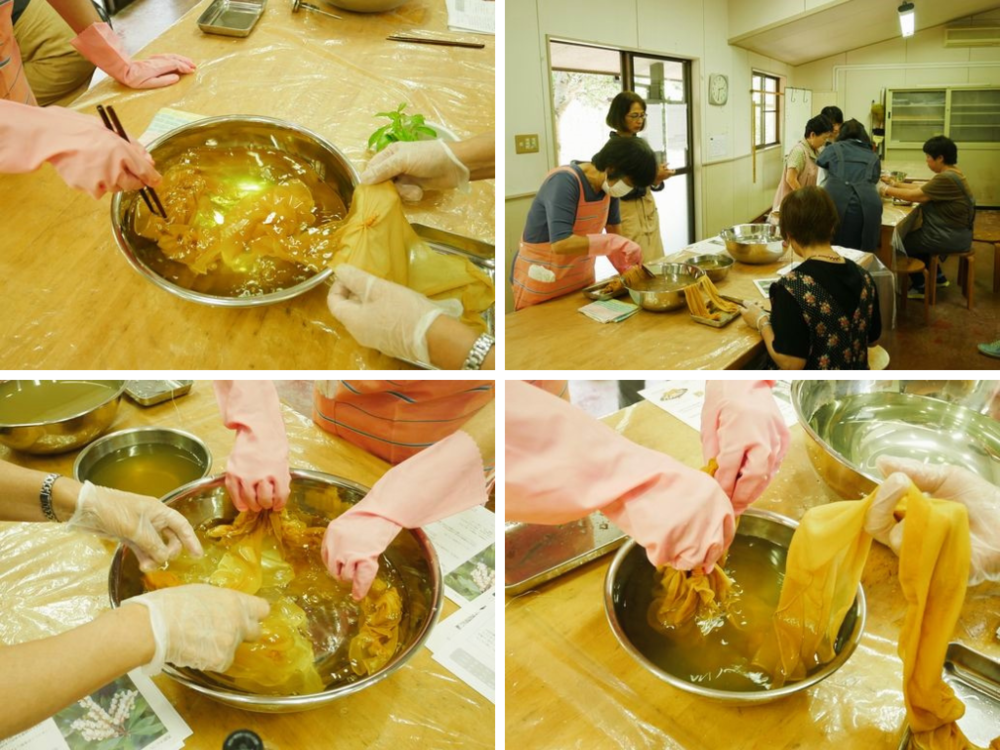
▲Top left: Soak in alum (mordant solution) (second time), Top right: Soak in lye (scum/mordant solution), Bottom left: Wash with fresh water, Bottom right: Soak in iron (mordant solution)
When I returned to the workshop, I removed the cloth from the dye solution, wringed it out, and dyed it in alum again for 10 minutes.
You can soak the entire cloth to get an even finish, or just a part of the cloth to create a gradation. At this time, the key is to soak the dye until you get the finish you want.
After soaking in alum, remove from the bowl, wash with fresh water, drain, and soak in the second mordant solution for 10 minutes. The second type of mordant is lye (lye/alkaline mordant).
When you layer acrylic mordant on top of alum mordant, it becomes more yellowish.
After soaking it in the aku, wash it again with fresh water and drain it, then move on to the final mordant solution. The third type of mordant is iron (iron mordant).
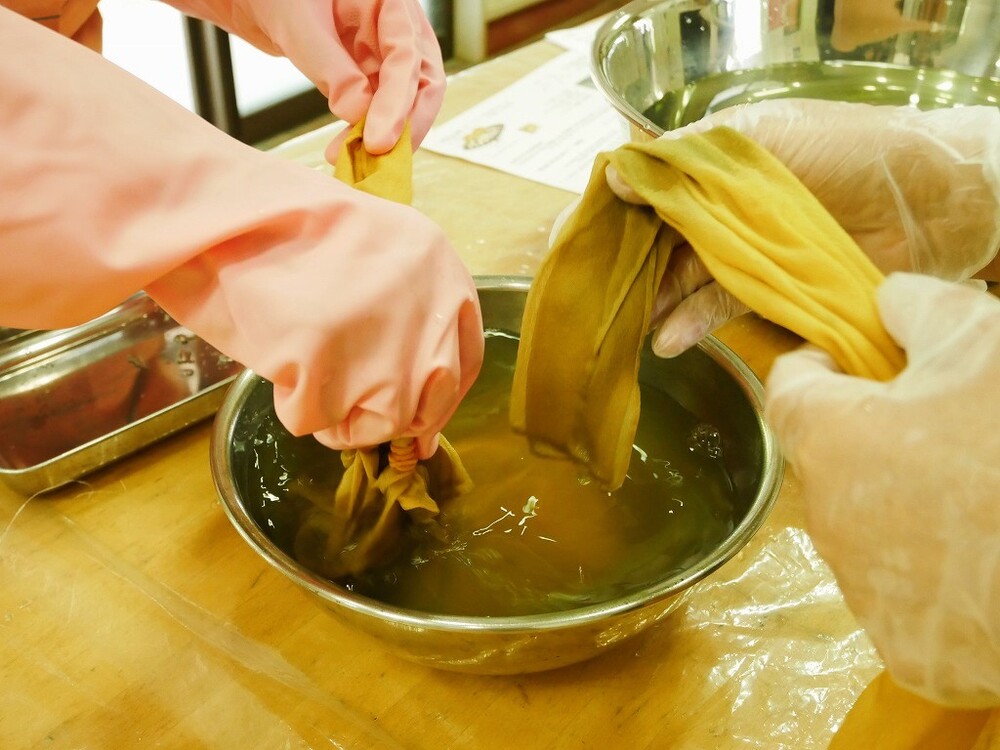
▲Pay attention to the color of the cloth that changes depending on the osmotic pressure!
Iron mordant produces a darker color.
Both scum and iron are absorbed rapidly by osmotic pressure. Please make adjustments while watching how the color of the cloth changes after dyeing it with a mordant solution made from horse-dried wood and soaking it in a mordant solution made from alum.
How is the finished product? ?
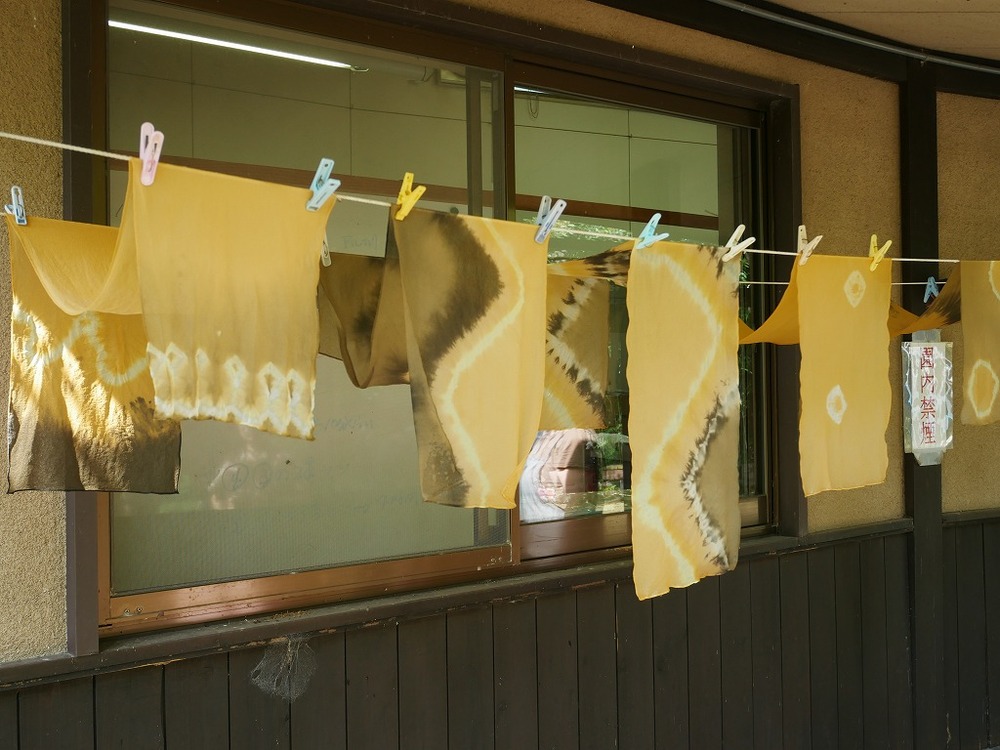
Once the iron mordant has been finished, rinse thoroughly with water and you’re done. Let’s dry it in the space under the eaves of the workshop.
In the image above, when I asked the people who dyed the second and third pictures from the left how to create the pattern, they both said, “I was able to do it by squeezing it while looking at the teacher’s example.”
Even if the scarves were squeezed in the same way, the resulting scarves would be dyed differently depending on how they were soaked in the mordant solution.
This way of squeezing is nice. I’ll try to imitate it the next time I participate in the Manyo plant dyeing experience.
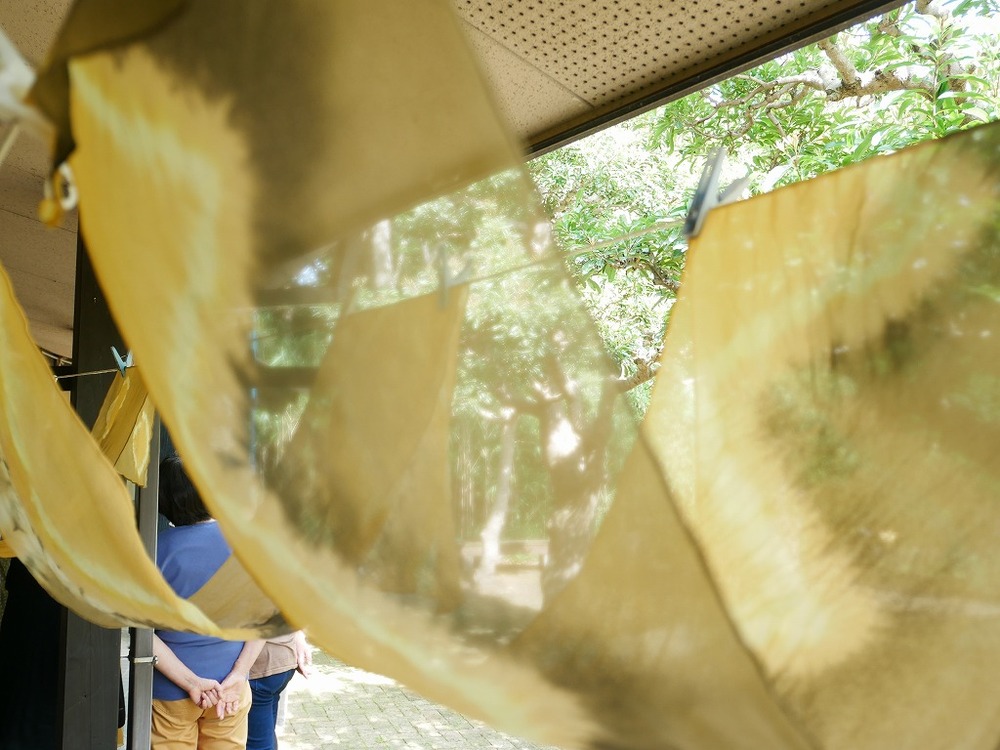
▲The trees in front of the workshop can be seen through the thin and soft silk chiffon scarf.
Safflowers, gardenias, indigo and oak vines…
People from the Manyo period (Asuka to Nara period) dyed cloth with natural pigments extracted from familiar plants.
Some natural dyes dye brightly, like safflower, while others dye subdued colors.
Depending on how you squeeze and dye, you can freely dye the product.
The more time-consuming it is, the more adorable it is.
Create an original piece with Manyo plant dyeing experience!
- 2023 Manyo plant dyeing experience implementation date●
1) Basuigi…Holding date: May 21st (Sunday) / Application start…April 16th (Sunday)
2) Shinhan…Date: September 17th (Sunday) / Application start…August 16th (Wednesday)
3) Plum…Date: December 17th (Sunday) / Application start date: November 16th (Thursday)
4) Tsubaki…Date: March 17, 2024 (Sunday) / Application start…February 16, 2024 (Friday)
- Time…Morning session: 10:00-12:00 / Afternoon session: 13:00-15:00 (Capacity 12 people each session)
- Application location…Manyonomori Park (Telephone number: 053-586-8700) *Applications start from 9:00 on the application start date
*Residents living outside Hamamatsu City can also apply.
*This time, we interviewed the first Masuiki.
<How to access Manyo-no-Mori Park>
Address : 5051-1 Hiraguchi, Hamakita Ward, Hamamatsu City
Closed : Every Monday (the next day if Monday is a holiday), New Year holidays December 29th to January 3rd
Phone : 053-586-8700
Access : About 8 minutes by taxi after getting off at Enshu Railway Hamakita Station
For cars : Parking lot…First parking lot: 40 regular cars, 5 buses / Second parking lot: 20 regular cars (Fudoji Shita)
Manyōnomori Park official website (external link)
